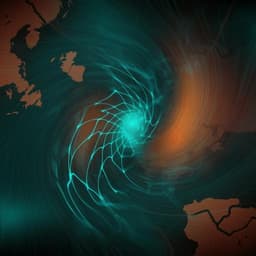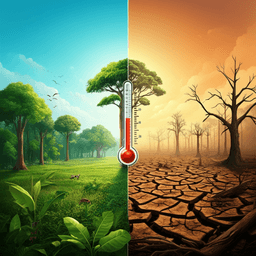
Environmental Studies and Forestry
Large carbon sink potential of secondary forests in the Brazilian Amazon to mitigate climate change
V. H. A. Heinrich, R. Dalagnol, et al.
This groundbreaking research, conducted by Viola H. A. Heinrich and colleagues, reveals that tropical secondary forests can sequester carbon at astonishing rates, up to 20 times faster than traditional old-growth forests. By utilizing satellite data, the study highlights the impact of environmental and disturbance factors on carbon sequestration in the Brazilian Amazon.
~3 min • Beginner • English
Introduction
Global forests are central to climate mitigation under the Paris Agreement via reduced deforestation and stimulated forest regrowth. The Brazilian Amazon (occupying ~3% of land and storing ~10% of global forest carbon) has acted as both a sink from natural growth and a source from deforestation. Brazil’s NDC pledges include restoring 12 Mha of forests by 2030, with secondary forest regeneration on abandoned land already occurring on ~20% of deforested areas. Prior estimates suggest young (<20 years) secondary forests accumulate carbon far faster than old-growth, but biome-wide averages from limited field plots cannot resolve spatial variation driven by environment (shortwave radiation, precipitation, water deficit, soils) and human disturbances (fire, repeated deforestation). Old-growth sinks may be declining due to warming and drought, underscoring the need to understand spatial and temporal drivers of secondary regrowth. This study asks how environmental and disturbance drivers control spatial patterns and rates of secondary forest regrowth across the Brazilian Amazon, and what carbon sink these forests can provide now and under preservation scenarios relative to Brazil’s NDC.
Literature Review
Previous Neotropical studies estimated average secondary forest net carbon uptake around 2.95–3.05 Mg C ha−1 yr−1, far exceeding old-growth rates, but lacked spatially explicit treatment of key drivers. Environmental controls include shortwave radiation, precipitation, maximum cumulative water deficit (MCWD), and soil fertility; anthropogenic disturbances include fire and repeated deforestation. Strong water deficits can reduce secondary forest carbon stocks by up to 85% relative to no deficit. Old-growth Amazonian forests show reduced growth with rising temperatures and drought, suggesting a peaking and subsequent decline of their sink. Satellite archives (e.g., Landsat) enable tracking secondary forest demography, revealing frequent 5–10 year cycles of clearance and abandonment and that secondary forest clearing accounted for ~70% of total Amazonian forest loss (2008–2014). However, no prior study had spatially explicit assessment of secondary forest regrowth drivers across Amazonia using global remote-sensing products. Comparisons to basin-wide models and Brazil’s GHGI suggest that not accounting for drivers and disturbances may overestimate regrowth.
Methodology
Data and mapping: Secondary forests and ages (1985–2017) were identified from MapBiomas Collection 3.1 (30 m). Pixels transitioning from anthropogenic (0) to forest (1) and remaining forest were classified as secondary forest; ages reset after any deforestation. Forests without transition since 1985 were considered old-growth. Misclassified perennial crops/plantations were removed using TerraClass-2014. Secondary forest polygons within 3 km of field inventory sites were excluded for cross-validation.
Aboveground carbon (AGC): ESA-CCI Aboveground Biomass (AGB) 2017 (100 m) was used to derive AGC (biomass-to-carbon 2:1). Only secondary forest patches >9000 m² were retained. Modal AGC per polygon was extracted via zonal statistics and aggregated by age using median values; a bias correction aligned 1-year AGC near 0.
Drivers: Six drivers were compiled and resampled to 30 m: (1) mean annual downward shortwave radiation (1985–2017), (2) mean annual precipitation (1985–2017), (3) mean MCWD (1985–2017), (4) Soil Cation Concentration (SCC), (5) annual burned area (2001–2017), and (6) number of deforestations prior to regrowth (1987–2017). Zonal statistics were computed for each secondary forest unit. Drivers were grouped by thresholds (e.g., 25th/50th/75th percentiles) to stratify conditions.
Regrowth modeling: AGC versus age was modeled using the Chapman–Richards (Richards) growth function Y_t = A(1 − e^(−kt))^c, with asymptote A set to the median, bias-corrected old-growth AGC under each driver condition/region. Nonlinear least squares (R nlstools::nls) estimated parameters. Models assessed whether and when secondary forests reached old-growth AGC.
Driver importance: Conditional random forests (R caret::cforest) quantified variable importance, robust to mixed data types and correlated predictors. A stratified random sample of ~0.1% (n≈2500) of data was split 80/20 train/test; 30 iterations with 500 trees each estimated conditional permutation importances, summarized as rankings.
Regionalization: K-means clustering on climate drivers (SW radiation, precipitation, MCWD) delineated four climatological regions. Within each, disturbances were subclassified (fire yes/no; repeated deforestation yes/no), yielding 16 regional regrowth models with region-specific old-growth AGC asymptotes. Regional driver importances used n=1500 per region.
Carbon stock and sink estimation: 2017 secondary forest AGC stock and net 2016–2017 change were computed by applying appropriate regional/disturbance-specific regrowth models to each pixel by age, accounting for area gains/losses. A counterfactual no-disturbance scenario estimated potential 2017 stock. Future potential (2017–2030) under preservation scenarios preserved: (1) all secondary forests (13.8 Mha), (2) ages ≥5 years (9.5 Mha), (3) ≥10 years (5.6 Mha), (4) ≥15 years (3.5 Mha), (5) ≥20 years (2.2 Mha), by aging the 2017 cohort and applying regional models. Validation used 284 field AGC samples across 33 locations and comparisons with basin-wide models and Brazil’s GHGI equations.
Key Findings
- Spatial variation in regrowth: Young (<20 years) secondary forests in western Amazonia accumulate carbon ~60% faster than in the east: 3.0 ± 1.0 vs 1.3 ± 0.3 Mg C ha−1 yr−1. In the North-West region, rates ranged 2.4–3.0 Mg C ha−1 yr−1; in North-East and South-East, rates were lower (1.3 ± 0.3 and 1.8 ± 0.3 Mg C ha−1 yr−1), dropping to ~0.6 Mg C ha−1 yr−1 under combined disturbances.
- Driver effects: After age, shortwave radiation was the most important driver. Very low SW radiation (<170 W m−2) yielded regrowth ~3.4 ± 0.6 Mg C ha−1 yr−1 vs ~1.3 ± 0.4 under high radiation (>187 W m−2). Water status mattered: areas with very low MCWD (>-180 mm yr−1) regrew at 2.7 ± 0.7 vs 1.5 ± 0.2 Mg C ha−1 yr−1 under very high deficit (<−350 mm yr−1). SCC showed weak or reversed trends at biome scale, likely masked by broader climatic controls.
- Disturbances: Fire occurrence (affecting 29.2% of plots) had importance comparable to top environmental drivers; repeated deforestations (26.3% of plots) had lowest biome-wide importance but still reduced regrowth by ~40% in areas with 3+ prior deforestations. Disturbances reduced regrowth by 8–55% regionally; combined fire and repeated deforestation produced the largest reductions, with AGC plateaus within 11–40 years, potentially never reaching old-growth levels.
- Regional controls: Western regions (cloudier, wetter, low radiation, low water deficit) experienced high regrowth and limited disturbance impacts (~20% reduction). Drier southern and eastern regions (higher radiation, higher water deficit) showed stronger sensitivity to fire and deforestation (up to ~55% reduction), aligning with the Arc of Deforestation.
- Stocks and annual fluxes (2016–2017): Secondary forests gained 28.0 Tg C yr−1 from growth and recruitment of new secondary forests, lost 16.1 Tg C yr−1 from area reduction, netting +11.9 Tg C yr−1. Total 2017 secondary forest AGC stock was 293.7 Tg C; without disturbances since establishment, potential stock would have been 319.7 Tg C (~8% higher).
- Future mitigation potential: Preserving all 2017 secondary forests (13.8 Mha) could accumulate ~19.0 ± 2.4 Tg C yr−1 to 2030, equivalent to ~5.5 ± 0.7% of Brazil’s 2025/2030 emissions reduction targets. Preserving only forests >20 years old (2.2 Mha) would yield ~2.0 ± 0.2 Tg C yr−1 (<1% of target).
- Comparisons: Regional ‘no-disturbance’ models matched prior basin-wide models in early years; GHGI equations significantly overestimated regrowth across regions, especially where disturbances are prevalent.
- Recovery times: Even under favorable, undisturbed conditions, time to reach old-growth AGC typically exceeds ~100 years; old-growth stocks cannot be replaced on policy-relevant timescales.
Discussion
The study disentangles how climate and human disturbances shape secondary forest regrowth across Amazonia. Low shortwave radiation—likely reflecting high cloudiness and diffuse light and lower vapour pressure deficit—enhances productivity and regrowth, explaining higher western rates. Synergistic driver patterns in drier eastern/southern regions (lower precipitation, higher MCWD, higher radiation) reduce growth and increase fire susceptibility, compounding regrowth suppression. Fire emerges as a key control in southern regions, while repeated deforestation further degrades regrowth capacity; their combination leads to arrested succession and early AGC plateaus. These findings explain spatial heterogeneity and challenge biome-wide assumptions used in inventories (e.g., GHGI), which may overestimate sinks by ignoring disturbances and regional climates. While secondary forests can provide a sizable, near-term sink aiding Brazil’s NDCs if preserved, their capacity is threatened by increasing drought, fires, fragmentation, and shifts toward lower-biomass, dry-affiliated species. Moreover, secondary forests cannot replace old-growth stocks within decades; conserving old-growth while protecting and managing secondary forests is essential for sustained mitigation.
Conclusion
This work provides spatially explicit, driver-informed regrowth models for Brazilian Amazon secondary forests, quantifying current and potential carbon sinks. It shows that preserving existing secondary forests could deliver ~19 Tg C yr−1 through 2030 (~5.5% of Brazil’s NDC reduction), but regrowth is highly sensitive to climate and disturbances, and recovery to old-growth AGC generally exceeds a century. Policy implications include urgently protecting secondary forests, reducing fires and repeated clearing, and conserving old-growth sources. Future research should integrate additional drivers such as proximity to undisturbed and secondary forests, detailed land-use histories (agriculture vs. pasture duration), disturbance intensity, and species/wood density dynamics, and extend the approach to other tropical regions to inform restoration targeting and monitoring (e.g., REDD+).
Limitations
- Temporal data constraints: Secondary forest ages span 1985–2017, but AGC is from a single year (2017), necessitating a space-for-time substitution. Model projections beyond the observational period carry uncertainty.
- Product uncertainties: ESA-CCI AGB (2017) was early-release; MapBiomas may misclassify certain land uses (mitigated with TerraClass-2014 filtering). Burned area detection underestimates by ~25% compared to manual interpretation, likely underrepresenting fire impacts.
- Classification limits: Secondary forests that regrew before 1985 cannot be identified; small-scale deforestation (<1 ha) may be missed due to resolution, biasing repeated deforestation estimates.
- Model assumptions: Regrowth models force asymptotes to old-growth AGC medians per region/condition, potentially inflating error given old-growth heterogeneity. Assumes eventual convergence to old-growth AGC, which may not occur under persistent disturbances.
- Spatial scale: Environmental drivers act regionally, while disturbances can be highly local; aggregated regional models may undercapture local effects (e.g., edge, fragmentation).
- External drivers not included: Proximity to undisturbed/secondary forests, detailed prior land-use intensity, and species composition/wood density dynamics were not explicitly modeled.
- Generalizability and changing climate: Increasing drought, fire, and community shifts may alter future regrowth trajectories relative to historical patterns used here.
Related Publications
Explore these studies to deepen your understanding of the subject.







